The Bay Trail Preview: Intel Atom Z3770 Tested
by Anand Lal Shimpi & Brian Klug on September 11, 2013 12:00 PM ESTIn addition to showing Bay Trail running on a Windows 8.x platform, Intel showed us a “pre-beta” version of the platform running Android 4.2.2. I have to emphasize that the build they showed us definitely seemed pre-beta, as there was some instability, but overall the build was good enough to run some tests on and get a feel for. Intel made it clear that they do have a lot more work to do on their Android build before it’s considered close to final quality than the Windows equivalent.
Inside Android we can still see the CPU state table data and how long the cores are sitting in each performance state still, despite this now being managed in-silicon on Bay Trail. In addition Android sees the 2.39 GHz Z3770 boost frequency and reports it. I didn’t see any strange behavior on the device while running tests and watching CPU frequency, if anything the reference design platform stayed at the maximum boost frequency even with four cores plugged in for an impressive amount of time. Of course this is a tablet so there’s more TDP to play around with compared to a phone.
Depending on where you were in the Android UI, there was some definite stutter, but I’m told this is a result of an issue with Dalvik not allocating threads to cores properly that Intel is still tuning, something which you can see plays itself out as well in the AndEBench Java test that runs in Dalvik. The launcher especially had some stutter, but Intel claimed they were aware of it and that final performance in areas like that would be dramatically improved. Regardless of the state of Bay Trail’s Android port, it affords us the opportunity to look at performance through our pretty standard benchmark suite.
On the CPU side for Android we’re still limited to just a few tests that rely on a combination of native code and stuff that runs inside the browser. That means AndEBench, JavaScript benchmarks, and part of Vellamo.
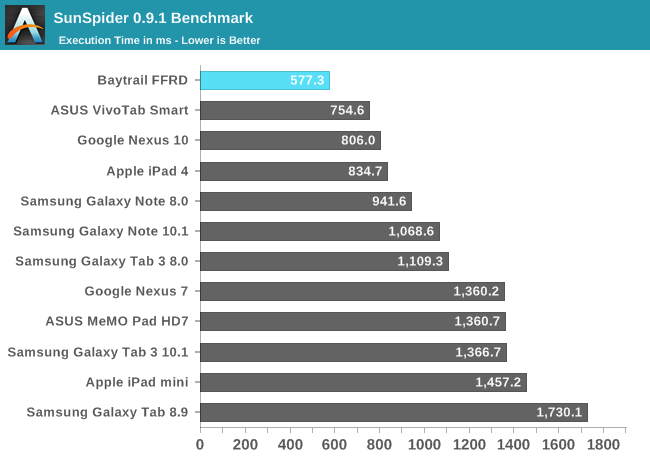
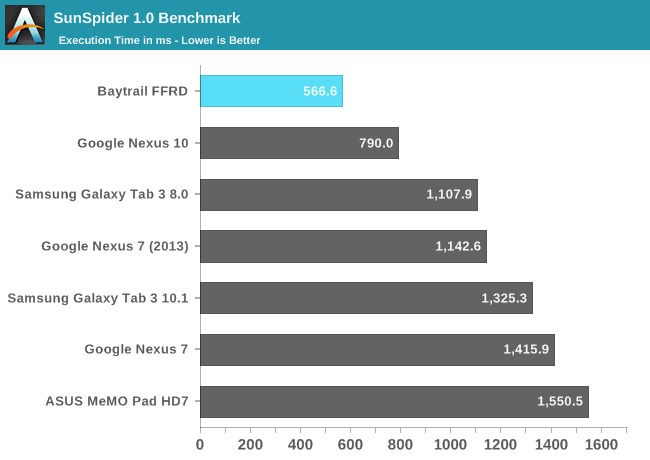
Sunspider has been a regular staple but in recent time has become an exercise in browser JavaScript engine optimization rather than actual performance. Nevertheless the FFRD takes the crown in both 1.0 and 0.9.1 (we have more tablet data from the 0.9.1 version so I replicated it here).
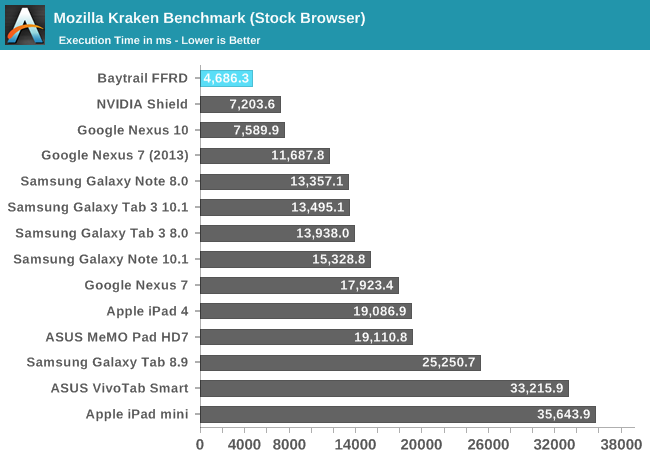
Kraken is another JavaScript benchmark which hasn’t quite been an optimization target everyone has gone after lately, and it’s also longer, which makes it a bit more reliable. Once again Bay Trail takes the crown here with notably faster JS engine performance.
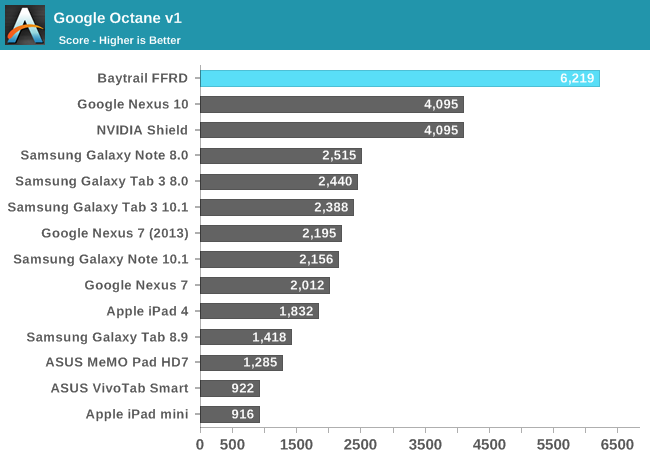
Google Octane is another JS test that isn’t quite as platform optimized yet, here there’s once again dominance by Bay Trail with just over a 50 percent higher score.
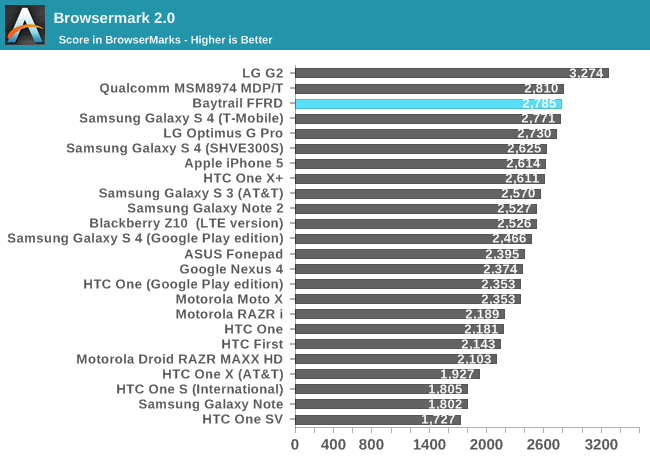
Browsermark has a combination of both JS tests and other web related performance metrics. Here the Bay Trail platform lags behind the 8974 based devices slightly. This isn’t a raw JavaScript benchmark again but rather a more holistic web browsing performance test, so it’s interesting to see Bay Trail a bit behind here.
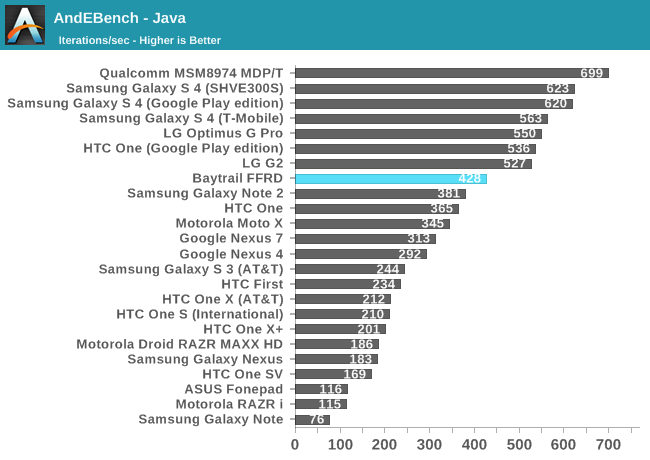

AndEBench is a combination native compiled microkernel benchmark (indicative of NDK application performance) that also runs a very similar workload atop Dalvik like a normal Android Java application. Here we can see what Intel was talking about when they said they have more work to do getting Dalvik working properly at dispatching threads to appropriate cores, hopefully the Java number will climb considerably. The native test also shows a lead over the competition.
GPU Performance
While Bay Trail clearly leads on the CPU side, its GPU performance is more middle of the road - at least among the higher end SoCs. In 3DMark Bay Trail's GPU performance is aided by the more CPU bound nature of the benchmark, but here Intel is able to beat the Snapdragon 600. Snapdragon 800 on the other hand pulls ahead by around 35%.
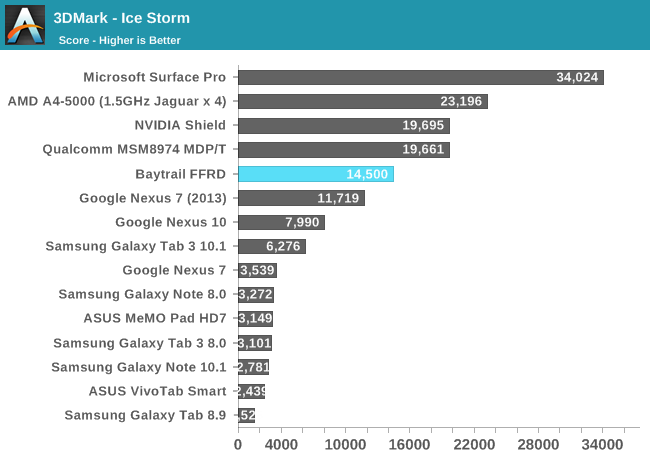
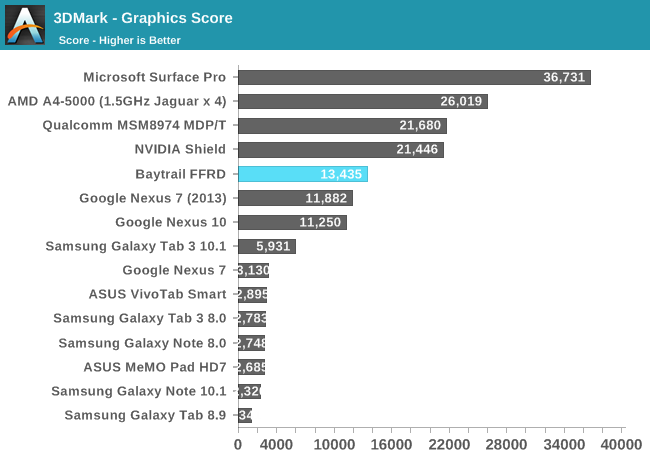
The 3DMark Physics test is effectively a CPU test, which once again plays to Bay Trail's strengths. Here it's faster than Snapdragon 800 and Cortex A15. Only Ivy Bridge is quicker in a tablet.
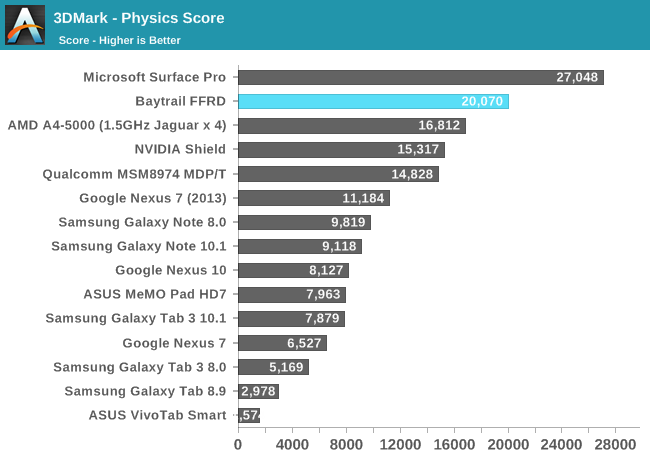
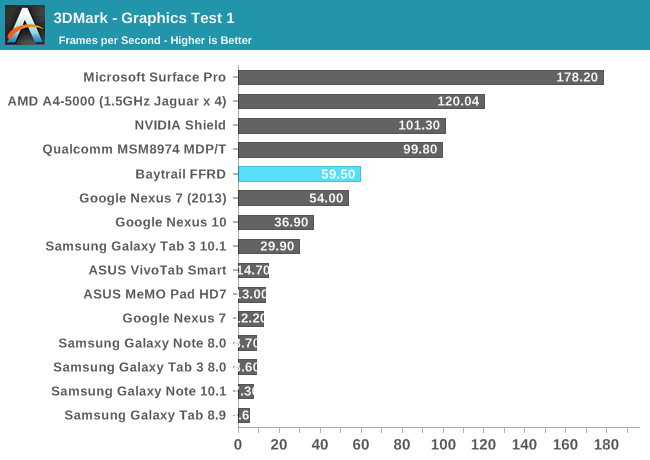
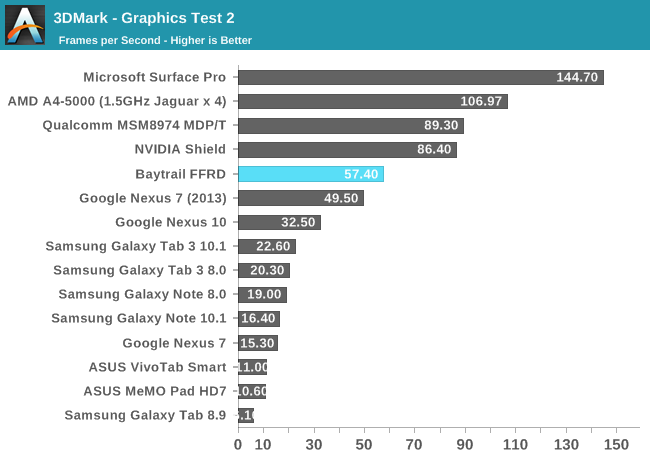
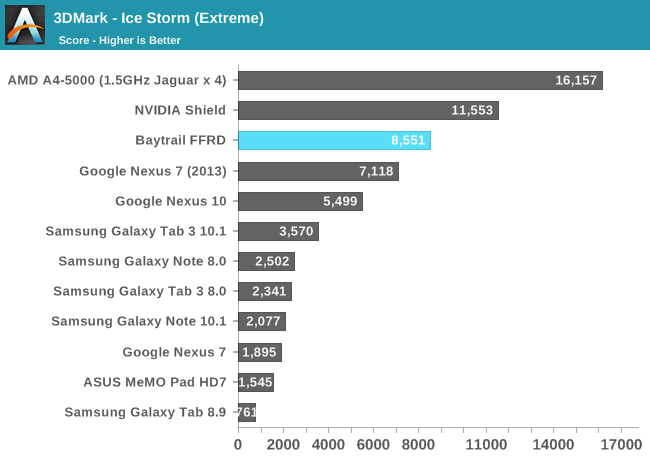
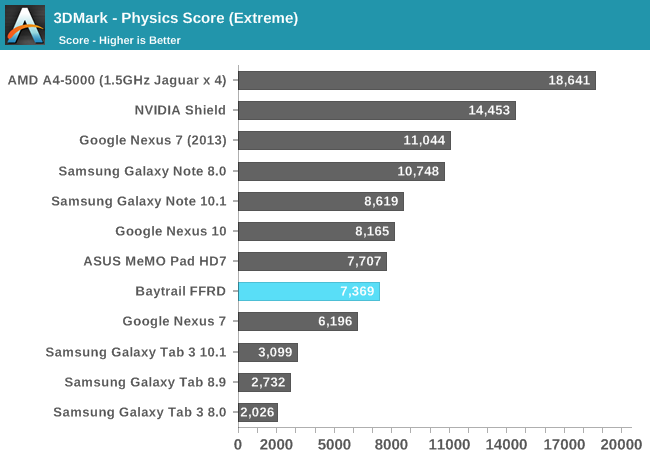
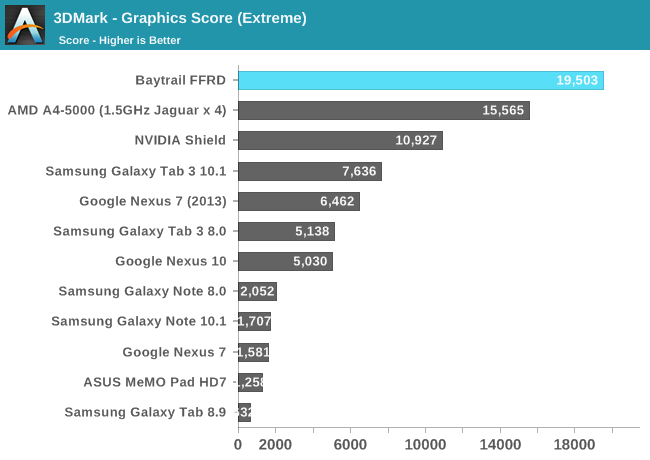
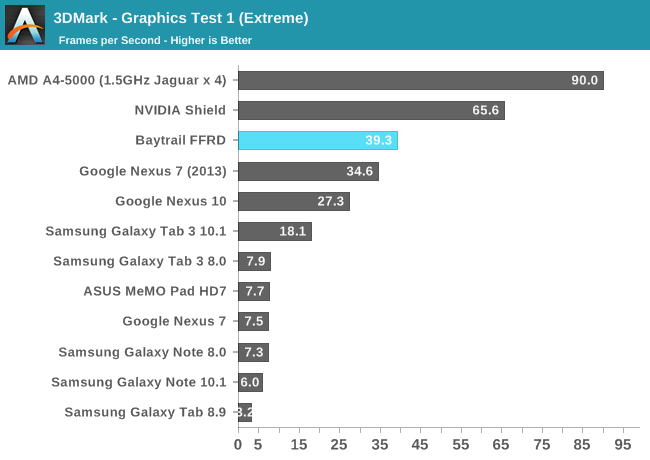
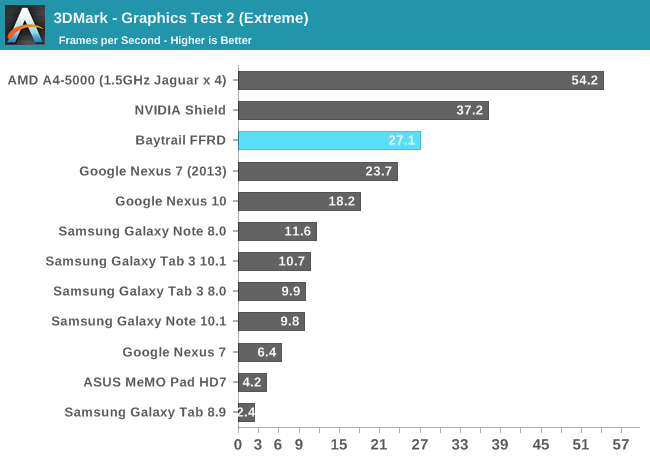
Basemark X
Basemark X is a bit more GPU bound than 3DMark, and we also have iOS data here so we can put Bay Trail's performance in better perspective. Here Bay Trail is a bit slower than the iPad 4, and clearly Tegra 4 and Snapdragon 800. Intel's GPU in Android is measurably quicker than Adreno 320/S600 though.
Bay Trail's onscreen performance is penalized by the FFRD's extremely high native resolution.

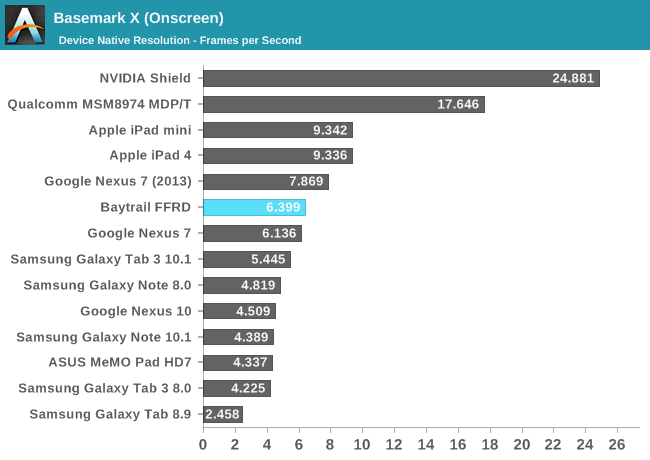
GLBenchmark 2.7
The more interested GLBenchmark numbers, T-Rex HD, show Bay Trail just behind the iPad 4 in performance. It's definitely not bad at all but clearly not industry leading.
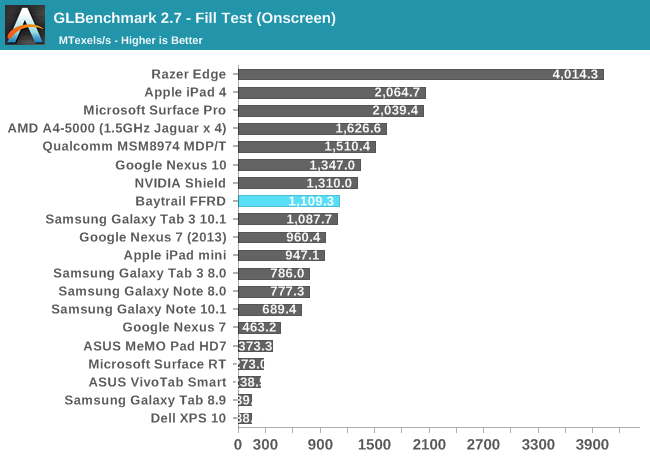
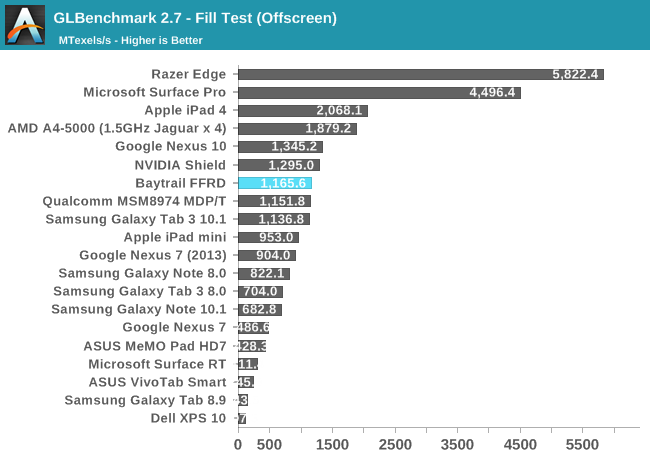
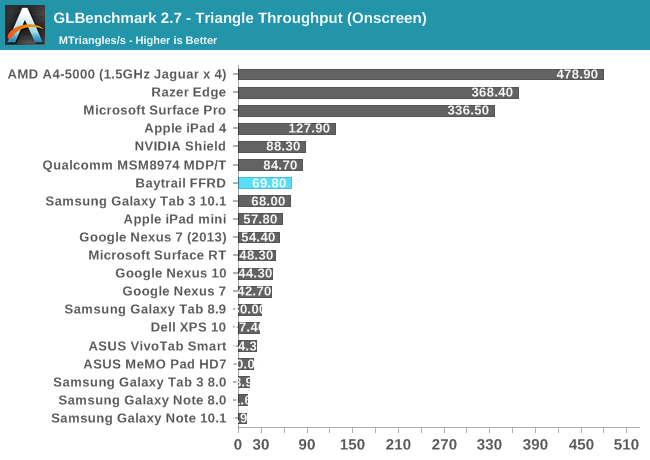
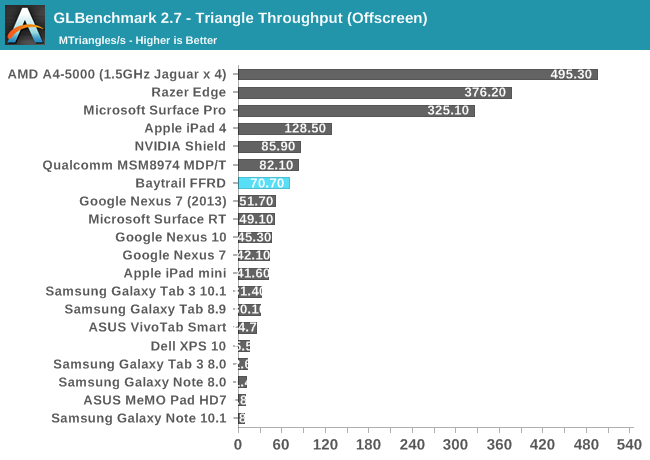
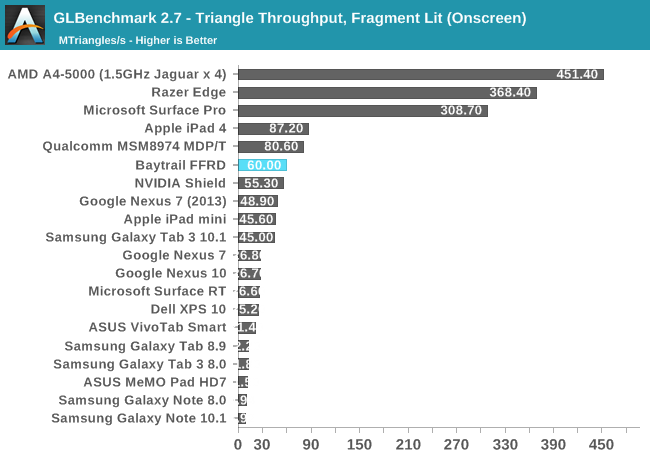
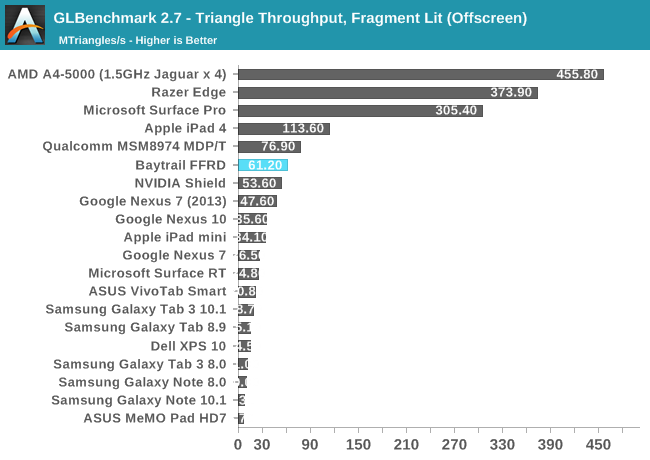
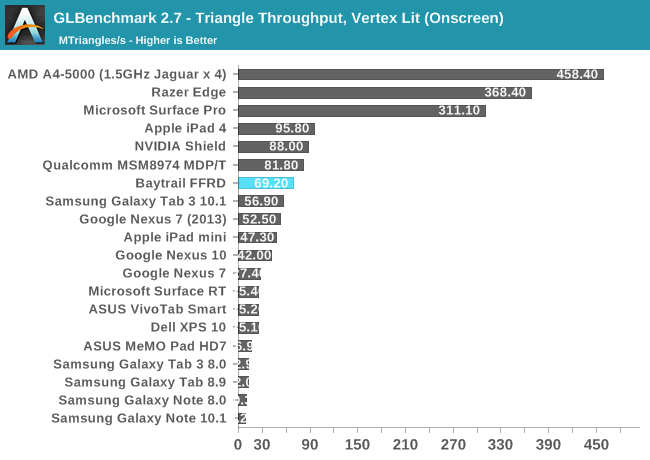
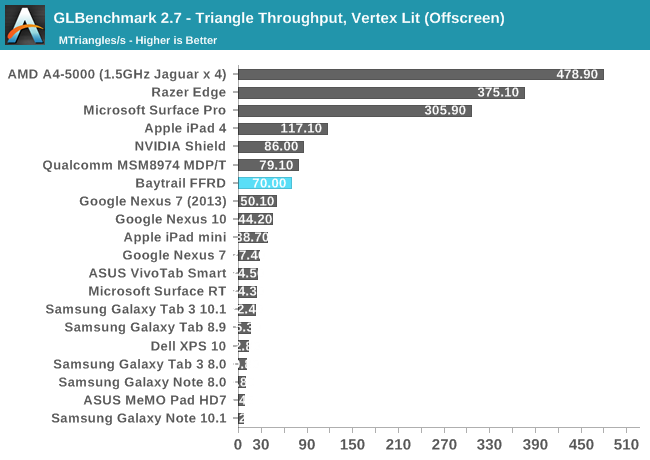
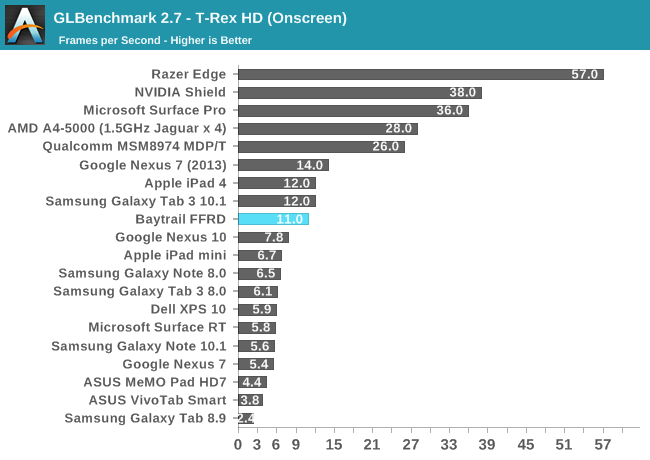
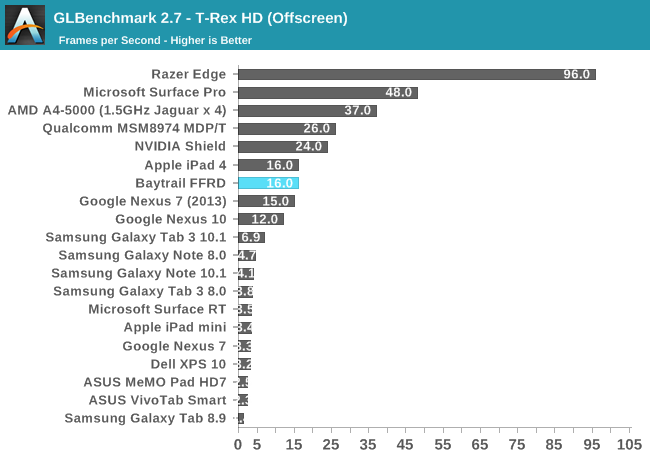
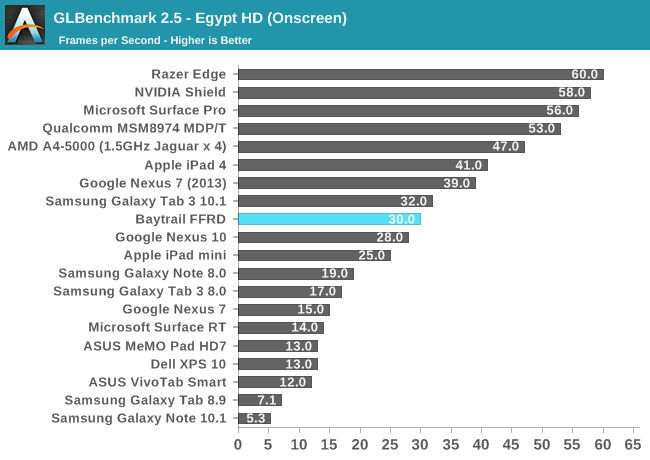
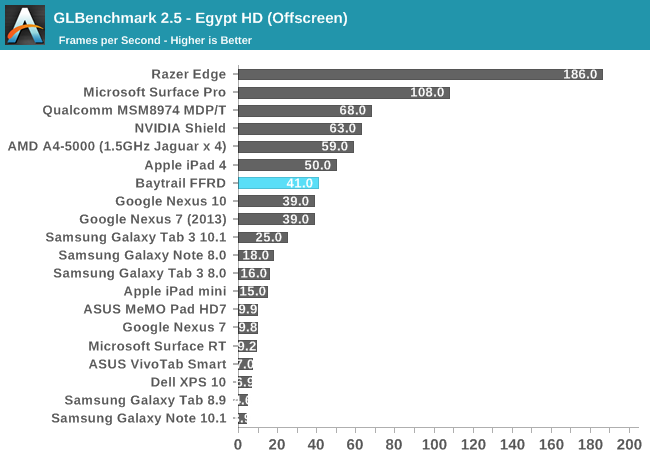
















190 Comments
View All Comments
Kidster3001 - Thursday, September 12, 2013 - link
Not to mention that Intel is the largest contributor to AOSP in the world... and has been for a few years now.dwade123 - Wednesday, September 11, 2013 - link
RIP ARM.Anders CT - Wednesday, September 11, 2013 - link
Who do you think will use Bay Trail rather than, say, a Snapdragon in their devices?virtual void - Wednesday, September 11, 2013 - link
Anyone that understands the value of really good single-threaded performance on integer workloads as that is by far the most important property for a tablet would be stupid not to select Bay Trail.Almost every single Android application runs on x86 based Medfield phones, so compatibility with existing Android-applications is a non-issue.
It comes down to price of the device, if the Silvermont based Android tablets end up at roughly the same price, why wouldn't I want the better performing one (battery life seems to be about the same)?
Anders CT - Wednesday, September 11, 2013 - link
I see two problems with this: The apps where single-threaded performance is critical, is the very apps that are likeely to contain optimized native code.Second: I doubt that Bay Trail while be competitive on price, especially if you factor in the apparent lack of on-chip LTE and Wifi modems.
Maybe we will se a lot of Android laptops (I'm writing this on Android laptop with Tegra 4 btw), but on a bigger screen you tend to be pushing a lot of pixels, and then you need a bigger GPU.
I'm not saying that Bay Trail will be a failure. I just don't see a lot of reason for OEMs to jump ship on Qualcomm.
Dentons - Wednesday, September 11, 2013 - link
Intel isn't going to kill ARM. While Intel is finally releasing a product that's competitive with ARM, it's probably five or six years too late. To paraphrase from above, convincing existing ARM vendors to move to Intel will not be an easy task. There will be huge costs involved in any such move.In order to convert ARM customers, Intel would need either far better performance or far better price points, and probably both. It seems unlikely that Intel has either.
Even with these latest chips, Intel's performance is only minimally better than ARM's current offerings, and while we don't know pricing, given that Intel has the highest margins in the industry and ARM among the lowest, one must assume that Intel's new silicon won't be price competitive with ARM.
Further, this chip's stand out feature is its X86 compatibility, something neither of the top mobile operating systems require or desire. ARM also allows mobile manufacturers a large, competitive marketplace from which to purchase CPU's. Were tablet manufacturers to spurn ARM, they'd drop themselves right back into Intel's high-margin arms.
These chips seems specifically designed to kill off Windows RT. In that alone, they'll probably succeed. Gaining real market share from ARM would require robust X86 versions of iOS and Android. While X86 Android does exist, almost entirely due to work by Intel themselves - there are tremendous application issues. Google seems unlikely to do much of the heavy lifting, the development would continue to be almost entirely the responsibility of Intel.
ARM has a massive lead. To keep that lead ARM just needs to stay good enough. ARM can win by staying reasonably competitive with Intel's performance while continuing to destroy them on price. Unless Intel brings both massive performance gains and tremendous price reductions, it won't be worthwhile for the big existing ARM players to lift heaven and earth to support X86.
Intel's only hope is X86 Windows 8 for tablets takes off. Good luck with that. Devices with a full WinTel tax will never be cost competitive with ARM / Android.
zeo - Wednesday, September 11, 2013 - link
Intel already got the ATOM within less than $10 to no more than $20 more than an ARM SoC for the ATOM SoC... And Bay Trail will be priced even lower than the present ATOM!And they already are competitive on power efficiency, leaving performance as the last thing they needed to excel at and Bay Trail looks to get enough for it to count...
Mind, Intel doesn't have to deal with hardware fragmentation as their own driver support for their own GPU is far better than most of the closed drivers used for the proprietary graphics used by the majority of ARM devices.
And people are more used to using desktop Linux on Intel systems anyway... So don't underestimate their chances too much, they're far from terrible...
TheinsanegamerN - Wednesday, September 11, 2013 - link
see, her is the issue. 10-20 bucks more means the chip is wither 50% or 100% more expensive then the competitor, and offers only a small improvement performance wise. add in atom's tainted name, its no wonder that OEMs dont want to use atom as much as, say, qualcomm chips.TheinsanegamerN - Wednesday, September 11, 2013 - link
*here, not herNagorak - Thursday, September 12, 2013 - link
And how exactly do you know that OEMs don't want to use Intel chips? Because the day it's announced there aren't tons of Atom based tablets available in the store?Samsung even used the old Atom in their Galaxy Tab 3, and this Atom is like three times better. The idea that OEMs are going out of their way to avoid Atoms is not reality.